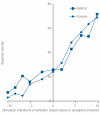Visual hallucinations in dementia with Lewy bodies: transcranial magnetic stimulation study
- PMID: 22016436
- PMCID: PMC3227808
- DOI: 10.1192/bjp.bp.110.090373
Visual hallucinations in dementia with Lewy bodies: transcranial magnetic stimulation study
Abstract
Background: The aetiology of visual hallucinations is poorly understood in dementia with Lewy bodies. Pathological alterations in visual cortical excitability may be one contributory mechanism.
Aims: To determine visual cortical excitability in people with dementia with Lewy bodies compared with aged-matched controls and also the relationship between visual cortical excitability and visual hallucinations in dementia with Lewy bodies.
Method: Visual cortical excitability was determined by using transcranial magnetic stimulation (TMS) applied to the occiput to elicit phosphenes (transient subjective visual responses) in 21 patients with dementia with Lewy bodies and 19 age-matched controls.
Results: Phosphene parameters were similar between both groups. However, in the patients with dementia with Lewy bodies, TMS measures of visual cortical excitability correlated strongly with the severity of visual hallucinations (P = 0.005). Six patients with dementia with Lewy bodies experienced visual hallucination-like phosphenes (for example, seeing people or figures on stimulation) compared with none of the controls (P = 0.02).
Conclusions: Increased visual cortical excitability in dementia with Lewy bodies does not appear to explain visual hallucinations but it may be a marker for their severity.
Conflict of interest statement
None.
Figures




Comment in
-
Occipital transcranial magnetic stimulation in dementia with Lewy bodies.Br J Psychiatry. 2012 Apr;200(4):345; author reply 345-6. doi: 10.1192/bjp.200.4.345. Br J Psychiatry. 2012. PMID: 22474236 No abstract available.
Similar articles
-
Visual cortical excitability in dementia with Lewy bodies.Br J Psychiatry. 2016 May;208(5):497-8. doi: 10.1192/bjp.bp.114.152736. Epub 2015 Nov 5. Br J Psychiatry. 2016. PMID: 26541688 Free PMC article.
-
Occipital transcranial magnetic stimulation in dementia with Lewy bodies.Br J Psychiatry. 2012 Apr;200(4):345; author reply 345-6. doi: 10.1192/bjp.200.4.345. Br J Psychiatry. 2012. PMID: 22474236 No abstract available.
-
Visual hallucinations in Lewy body disease relate to Lewy bodies in the temporal lobe.Brain. 2002 Feb;125(Pt 2):391-403. doi: 10.1093/brain/awf033. Brain. 2002. PMID: 11844739
-
[Clinical and neuropathological characteristics of dementia with Lewy bodies].Orv Hetil. 2017 Apr;158(17):643-652. doi: 10.1556/650.2017.30735. Orv Hetil. 2017. PMID: 28434243 Review. Hungarian.
-
Visual hallucinations, thalamocortical physiology and Lewy body disease: A review.Neurosci Biobehav Rev. 2019 Aug;103:337-351. doi: 10.1016/j.neubiorev.2019.06.006. Epub 2019 Jun 10. Neurosci Biobehav Rev. 2019. PMID: 31195000 Review.
Cited by
-
A whole new world: embracing the systems-level to understand the indirect impact of pathology in neurodegenerative disorders.J Neurol. 2023 Apr;270(4):1969-1975. doi: 10.1007/s00415-022-11550-9. Epub 2022 Dec 29. J Neurol. 2023. PMID: 36577819 Review.
-
Visual cortical activity in Charles Bonnet syndrome: testing the deafferentation hypothesis.J Neurol. 2025 Feb 11;272(3):199. doi: 10.1007/s00415-024-12741-2. J Neurol. 2025. PMID: 39932561 Free PMC article.
-
Reduced occipital GABA in Parkinson disease with visual hallucinations.Neurology. 2018 Aug 14;91(7):e675-e685. doi: 10.1212/WNL.0000000000006007. Epub 2018 Jul 18. Neurology. 2018. PMID: 30021920 Free PMC article.
-
Exploring Bottom-Up Visual Processing and Visual Hallucinations in Parkinson's Disease With Dementia.Front Neurol. 2021 Jan 28;11:579113. doi: 10.3389/fneur.2020.579113. eCollection 2020. Front Neurol. 2021. PMID: 33584490 Free PMC article.
-
Cascaded Multimodal Deep Learning in the Differential Diagnosis, Progression Prediction, and Staging of Alzheimer's and Frontotemporal Dementia.medRxiv [Preprint]. 2025 Jul 21:2024.09.23.24314186. doi: 10.1101/2024.09.23.24314186. medRxiv. 2025. PMID: 40778154 Free PMC article. Preprint.
References
-
- Aarsland D, Ballard C, Larsen JP, McKeith I. A comparative study of psychiatric symptoms in dementia with Lewy bodies and Parkinson’s disease with and without dementia. Int J Geriatr Psychiatry 2001; 16: 528–36 - PubMed
-
- Bostrom F, Jonsson L, Minthon L, Londos E. Patients with dementia with Lewy bodies have more impaired quality of life than patients with Alzheimer disease. Alzheimer Dis & Assoc Disord 2007; 21: 150–4 - PubMed
-
- Ricci M, Guidoni SV, Sepe-Monti M, Bomboi G, Antonini G, Blundo C, et al. Clinical findings, functional abilities and caregiver distress in the early stage of dementia with Lewy bodies (DLB) and Alzheimer’s disease (AD). Arch Gerontol Geriatr 2009; 49: e101–4 - PubMed
-
- Collerton D, Perry E, McKeith I. Why people see things that are not there: a novel perception and attention deficit model for recurrent complex visual hallucinations. Behav Brain Sci 2005; 28: 737–57 - PubMed
-
- Diederich NJ, Goetz CG, Stebbins GT. Repeated visual hallucinations in Parkinson’s disease as disturbed external/internal perceptions: focused review and a new integrative model. Movement Disord 2005; 20: 130–40 - PubMed
Publication types
MeSH terms
Substances
Grants and funding
LinkOut - more resources
Full Text Sources
Other Literature Sources
Medical

